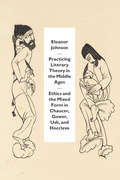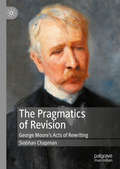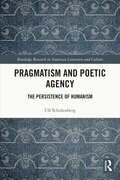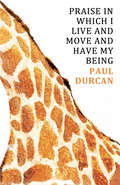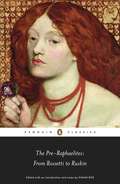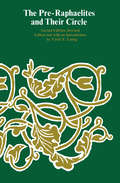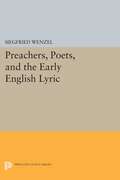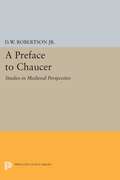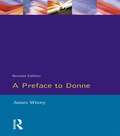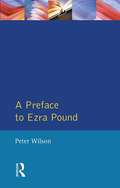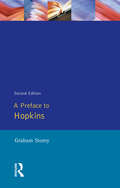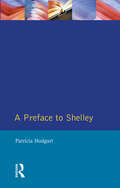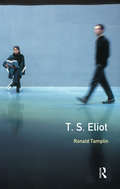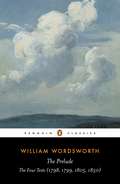- Table View
- List View
Practicing Literary Theory in the Middle Ages: Ethics and the Mixed Form in Chaucer, Gower, Usk, and Hoccleve
by Eleanor JohnsonLiterary scholars often avoid the category of the aesthetic in discussions of ethics, believing that purely aesthetic judgments can vitiate analyses of a literary work’s sociopolitical heft and meaning. In Practicing Literary Theory in the Middle Ages, Eleanor Johnson reveals that aesthetics—the formal aspects of literary language that make it sense-perceptible—are indeed inextricable from ethics in the writing of medieval literature. Johnson brings a keen formalist eye to bear on the prosimetric form: the mixing of prose with lyrical poetry. This form descends from the writings of the sixth-century Christian philosopher Boethius—specifically his famous prison text, Consolation of Philosophy—to the late medieval English tradition. Johnson argues that Boethius’s text had a broad influence not simply on the thematic and philosophical content of subsequent literary writing, but also on the specific aesthetic construction of several vernacular traditions. She demonstrates the underlying prosimetric structures in a variety of Middle English texts—including Chaucer’s Troilus and Criseyde and portions of the Canterbury Tales, Thomas Usk’s Testament of Love, John Gower’s Confessio amantis, and Thomas Hoccleve’s autobiographical poetry—and asks how particular formal choices work, how they resonate with medieval literary-theoretical ideas, and how particular poems and prose works mediate the tricky business of modeling ethical transformation for a readership.
Practicing Literary Theory in the Middle Ages: Ethics and the Mixed Form in Chaucer, Gower, Usk, and Hoccleve
by Eleanor JohnsonLiterary scholars often avoid the category of the aesthetic in discussions of ethics, believing that purely aesthetic judgments can vitiate analyses of a literary work’s sociopolitical heft and meaning. In Practicing Literary Theory in the Middle Ages, Eleanor Johnson reveals that aesthetics—the formal aspects of literary language that make it sense-perceptible—are indeed inextricable from ethics in the writing of medieval literature. Johnson brings a keen formalist eye to bear on the prosimetric form: the mixing of prose with lyrical poetry. This form descends from the writings of the sixth-century Christian philosopher Boethius—specifically his famous prison text, Consolation of Philosophy—to the late medieval English tradition. Johnson argues that Boethius’s text had a broad influence not simply on the thematic and philosophical content of subsequent literary writing, but also on the specific aesthetic construction of several vernacular traditions. She demonstrates the underlying prosimetric structures in a variety of Middle English texts—including Chaucer’s Troilus and Criseyde and portions of the Canterbury Tales, Thomas Usk’s Testament of Love, John Gower’s Confessio amantis, and Thomas Hoccleve’s autobiographical poetry—and asks how particular formal choices work, how they resonate with medieval literary-theoretical ideas, and how particular poems and prose works mediate the tricky business of modeling ethical transformation for a readership.
The Pragmatics of Revision: George Moore’s Acts of Rewriting
by Siobhan ChapmanThis book presents the first full-length study of the stylistically experimental and influential novelist George Moore’s (1852-1933) repeated acts of rewriting. Moore extensively and repeatedly revised and re-issued many of his major works, sometimes years or even decades after they were initially published. This monograph provides new insights into how this process shaped and determined his work, and by extension into the creative significance of literary rewriting more generally. It also offers the first sustained application of linguistic pragmatics, the study of meaning in interaction, to the work of a single author, opening up questions about how analytical paradigms developed in pragmatics can explain how rewriting can affect the interactive relationship between a literary text and its readers. The book will be of interest to students and researchers in the areas of pragmatics, stylistics, literary history, English literature and Irish literature.
Pragmatism and Poetic Agency: The Persistence of Humanism (Routledge Research in American Literature and Culture)
by Ulf SchulenbergPragmatism is a humanist philosophy. In spite of the much-debated renaissance of pragmatism, however, a detailed discussion of the relationship between pragmatism and humanism is still a desideratum. It is difficult to understand the complexity of pragmatism without considering the significance of humanism. At least since the 1970s, humanism, mostly in its liberal version, has been vehemently attacked and criticized. In pragmatism, however, a particular understanding of humanism has persisted. Bringing literary studies, philosophy, and intellectual history together and establishing a transatlantic theoretical dialogue, Pragmatism and Poetic Agency endeavors to elucidate this persistence of humanism. Schulenberg continues the thought-provoking argument he developed in his previous two monographs by advancing the idea that one can only grasp the unique contemporary significance of pragmatism when one realizes how pragmatism, humanism, anti-authoritarianism, and postmetaphysics are interlinked. If one appreciates the implications and consequences of this link, then one is in a position to see pragmatism’s antifoundationalist and antirepresentationalist story of progress and emancipation as continuing the project of the Enlightenment.
Pragmatism and Poetic Agency: The Persistence of Humanism (Routledge Research in American Literature and Culture)
by Ulf SchulenbergPragmatism is a humanist philosophy. In spite of the much-debated renaissance of pragmatism, however, a detailed discussion of the relationship between pragmatism and humanism is still a desideratum. It is difficult to understand the complexity of pragmatism without considering the significance of humanism. At least since the 1970s, humanism, mostly in its liberal version, has been vehemently attacked and criticized. In pragmatism, however, a particular understanding of humanism has persisted. Bringing literary studies, philosophy, and intellectual history together and establishing a transatlantic theoretical dialogue, Pragmatism and Poetic Agency endeavors to elucidate this persistence of humanism. Schulenberg continues the thought-provoking argument he developed in his previous two monographs by advancing the idea that one can only grasp the unique contemporary significance of pragmatism when one realizes how pragmatism, humanism, anti-authoritarianism, and postmetaphysics are interlinked. If one appreciates the implications and consequences of this link, then one is in a position to see pragmatism’s antifoundationalist and antirepresentationalist story of progress and emancipation as continuing the project of the Enlightenment.
Praise in Which I Live and Move and Have my Being
by Paul DurcanPaul Durcan's twenty-second collection finds Monsieur le Poète on the road in Paris, New York City, Chicago, Brisbane, and Achill Island, meditating upon the sanctuary of home and what it means to feel truly at home. Regarded by many as the great poet of contemporary Ireland, Durcan is on top form here as he contemplates the fall of the Celtic Tiger, while railing against bankers and 'bonus boys'. There are poems of love lost and won, and poems in memory of friends and relatives who have passed on, but there is also joy to be found in the birth of a grandson, and there is praise, too, for the modest heroism of truckers, air traffic controllers and nurses, those 'slim, sturdy, buxom nourishers' of fallen mankind. If for Sartre 'hell is other people', for Durcan 'heaven is other people, especially women'.
The Pre-Raphaelites: From Rossetti to Ruskin
by Dinah RoeThe Pre-Raphaelite Movement began in 1848, and experienced its heyday in the 1860s and 1870s. Influenced by the then little-known Keats and Blake, as well as Wordsworth, Shelley and Coleridge, Pre-Raphaelite poetry 'etherialized sensation' (in the words of Antony Harrison), and popularized the notion ofl'art pour l'art - art for art's sake. Where Victorian realist novels explored the grit and grime of the Industrial Revolution, Pre-Raphaelite poems concentrated on more abstract themes of romantic love, artistic inspiration and sexuality. Later they attracted Aesthetes and Decadents like Oscar Wilde, Aubrey Beardsley and Ernest Dowson, not to mention Gerard Manley Hopkins and W.B. Yeats.
The Pre-Raphaelites and Their Circle
by Edited by Cecil Y. LangThis useful volume presents the major works of the five leading Pre-Raphaelite poets. Foremost in the collection, and included in their entirety are D. G. Rossetti's The House of Life, C. G. Rossetti's "Monna Innominata," William Morris's "Defence of Guenevere," Swinburne's Atalanta in Calydon, and Meredith's "Modern Love." Complementing these major poems is a fine, generous selection of the poets' shorter pieces that are typical of their work as a whole. For this second edition, Cecil Lang has substituted two early Swinburne poems, "The Leper" and "Anactoria," for Fitzgerald's The Rubáiyát of Omar Khayyám. These poems, which the editor describes as "shocking," show a new aspect of Swinburne not discussed previously. Lang's Introduction describes briefly the founding of the Pre-Raphaelite Brotherhood, discusses each of the Pre-Raphaelite poets, both individually and in relation to the others, and grapples with the questions of definition of Pre-Raphaelitism and the similarities between its painting and poetry. The book is appropriately illustrated with thirty-two works by D. G. Rossetti, John Ruskin, William H. Hunt, and other Pre-Raphaelite artists. This is the only anthology available that provides a representative selection of the work of these important poets. It will be indispensable to students of Victorian poetry and appreciated by readers interested in the Pre-Raphaelites.
The Pre-Raphaelites and Their Circle
by Edited by Cecil Y. LangThis useful volume presents the major works of the five leading Pre-Raphaelite poets. Foremost in the collection, and included in their entirety are D. G. Rossetti's The House of Life, C. G. Rossetti's "Monna Innominata," William Morris's "Defence of Guenevere," Swinburne's Atalanta in Calydon, and Meredith's "Modern Love." Complementing these major poems is a fine, generous selection of the poets' shorter pieces that are typical of their work as a whole. For this second edition, Cecil Lang has substituted two early Swinburne poems, "The Leper" and "Anactoria," for Fitzgerald's The Rubáiyát of Omar Khayyám. These poems, which the editor describes as "shocking," show a new aspect of Swinburne not discussed previously. Lang's Introduction describes briefly the founding of the Pre-Raphaelite Brotherhood, discusses each of the Pre-Raphaelite poets, both individually and in relation to the others, and grapples with the questions of definition of Pre-Raphaelitism and the similarities between its painting and poetry. The book is appropriately illustrated with thirty-two works by D. G. Rossetti, John Ruskin, William H. Hunt, and other Pre-Raphaelite artists. This is the only anthology available that provides a representative selection of the work of these important poets. It will be indispensable to students of Victorian poetry and appreciated by readers interested in the Pre-Raphaelites.
The Pre-Raphaelites and Their Circle
by Cecil Y. LangThis useful volume presents the major works of the five leading Pre-Raphaelite poets. Foremost in the collection, and included in their entirety are D. G. Rossetti's The House of Life, C. G. Rossetti's "Monna Innominata," William Morris's "Defence of Guenevere," Swinburne's Atalanta in Calydon, and Meredith's "Modern Love." Complementing these major poems is a fine, generous selection of the poets' shorter pieces that are typical of their work as a whole. For this second edition, Cecil Lang has substituted two early Swinburne poems, "The Leper" and "Anactoria," for Fitzgerald's The Rubáiyát of Omar Khayyám. These poems, which the editor describes as "shocking," show a new aspect of Swinburne not discussed previously. Lang's Introduction describes briefly the founding of the Pre-Raphaelite Brotherhood, discusses each of the Pre-Raphaelite poets, both individually and in relation to the others, and grapples with the questions of definition of Pre-Raphaelitism and the similarities between its painting and poetry. The book is appropriately illustrated with thirty-two works by D. G. Rossetti, John Ruskin, William H. Hunt, and other Pre-Raphaelite artists. This is the only anthology available that provides a representative selection of the work of these important poets. It will be indispensable to students of Victorian poetry and appreciated by readers interested in the Pre-Raphaelites.
The Pre-Raphaelites and Their Circle
by Cecil Y. LangThis useful volume presents the major works of the five leading Pre-Raphaelite poets. Foremost in the collection, and included in their entirety are D. G. Rossetti's The House of Life, C. G. Rossetti's "Monna Innominata," William Morris's "Defence of Guenevere," Swinburne's Atalanta in Calydon, and Meredith's "Modern Love." Complementing these major poems is a fine, generous selection of the poets' shorter pieces that are typical of their work as a whole. For this second edition, Cecil Lang has substituted two early Swinburne poems, "The Leper" and "Anactoria," for Fitzgerald's The Rubáiyát of Omar Khayyám. These poems, which the editor describes as "shocking," show a new aspect of Swinburne not discussed previously. Lang's Introduction describes briefly the founding of the Pre-Raphaelite Brotherhood, discusses each of the Pre-Raphaelite poets, both individually and in relation to the others, and grapples with the questions of definition of Pre-Raphaelitism and the similarities between its painting and poetry. The book is appropriately illustrated with thirty-two works by D. G. Rossetti, John Ruskin, William H. Hunt, and other Pre-Raphaelite artists. This is the only anthology available that provides a representative selection of the work of these important poets. It will be indispensable to students of Victorian poetry and appreciated by readers interested in the Pre-Raphaelites.
Preachers, Poets, and the Early English Lyric
by Siegfried WenzelThe Middle English lyric is intimately related to late medieval preaching, not only because many lyrical poems have been preserved in sermon manuscripts, but also because preaching furnished a unique opportunity to create and utilize poems. Preachers, Poets, and the Early English Lyric explores this relationship in detail.Originally published in 1986.The Princeton Legacy Library uses the latest print-on-demand technology to again make available previously out-of-print books from the distinguished backlist of Princeton University Press. These editions preserve the original texts of these important books while presenting them in durable paperback and hardcover editions. The goal of the Princeton Legacy Library is to vastly increase access to the rich scholarly heritage found in the thousands of books published by Princeton University Press since its founding in 1905.
A Preface to Chaucer: Studies in Medieval Perspective (PDF)
by Durant Waite RobertsonWhat were the medieval stylistic, aesthetic, and literary conventions that Chancer drew upon and knew that his audience would understand? In this rich study Mr. Robertson has included 118 illustrations-of medieval sculpture, cathedral interiors, illuminated manuscripts, paintings, ornamental devices and decorations-to show how these conventions affected the visual arts of Chaucer's time. Special attention is directed to fundamental differences between medieval and modern attitudes toward poetry, and to the significance of these differences for an approach to medieval art. By placing Chaucer fully in his own time, Mr. Robertson establishes new perspectives for understanding Chaucer’s poetry. His book is like a rich tapestry weaving together many threads.Originally published in 1962.The Princeton Legacy Library uses the latest print-on-demand technology to again make available previously out-of-print books from the distinguished backlist of Princeton University Press. These editions preserve the original texts of these important books while presenting them in durable paperback and hardcover editions. The goal of the Princeton Legacy Library is to vastly increase access to the rich scholarly heritage found in the thousands of books published by Princeton University Press since its founding in 1905.
A Preface to Donne
by James WinnyProbably the most famous of the Metaphysical poets, John Donne worked with and influenced many of the leading poets of the age. This excellent introduction to his life and works sets his writing firmly in the context of his times.
A Preface to Donne
by James WinnyProbably the most famous of the Metaphysical poets, John Donne worked with and influenced many of the leading poets of the age. This excellent introduction to his life and works sets his writing firmly in the context of his times.
A Preface to Ezra Pound
by Peter WilsonProvides an introduction to the life and works of Ezra Pound, a major modernist poet, theorist and literary critic. Throughout his life Pound was regarded by many to be a contentious and controversial figure, and since his death in 1972, theoretical, literary, political and biographical comentators have done much to perpetuate this view. Peter Wilson's survey, however, presents a balanced view of his life and work allowing the reader to judge for themselves. The major sections of the book offer introductions to the complex life and work of Pound, outlining the various cultural, political and literary issues which are important to a full understanding of his place in twentieth century English literature. Critical commentaries are then given on all of Pound's major poetry, adopting some analytical techniques from stylistics. Brief biographies of important figures in Pound's career, and in the development of literary modernism are provided. A gazeteer, glossary, and suggestions for further reading complete the book.
A Preface to Ezra Pound
by Peter WilsonProvides an introduction to the life and works of Ezra Pound, a major modernist poet, theorist and literary critic. Throughout his life Pound was regarded by many to be a contentious and controversial figure, and since his death in 1972, theoretical, literary, political and biographical comentators have done much to perpetuate this view. Peter Wilson's survey, however, presents a balanced view of his life and work allowing the reader to judge for themselves. The major sections of the book offer introductions to the complex life and work of Pound, outlining the various cultural, political and literary issues which are important to a full understanding of his place in twentieth century English literature. Critical commentaries are then given on all of Pound's major poetry, adopting some analytical techniques from stylistics. Brief biographies of important figures in Pound's career, and in the development of literary modernism are provided. A gazeteer, glossary, and suggestions for further reading complete the book.
A Preface to Hopkins
by Graham StoreyAn authoritative guide to the life and works of Hopkins, for those who require a good introduction from which to explore the author's works more fully.
A Preface to Hopkins
by Graham StoreyAn authoritative guide to the life and works of Hopkins, for those who require a good introduction from which to explore the author's works more fully.
A Preface to Shelley
by Patricia HodgartThis volume discusses the life and work of Percy Bysshe Shelley in the social and political context of the world and time in which he lived.
A Preface to Shelley
by Patricia HodgartThis volume discusses the life and work of Percy Bysshe Shelley in the social and political context of the world and time in which he lived.
A Preface to T S Eliot (Preface Books)
by Ron TamplinT. S. Eliot is arguably the most influential poet of the 20th century, and The Waste Land one of its most significant poems. This introduction to the life and works of T.S. Eliot sets his writing clearly in the context of his times. Outlining his life and cultural background and their effect on his work, Ronald Tamplin examines his poetry and focuses in detail on three major works: The Waste Land, Four Quartets and the play, Murder in the Cathedral.
A Preface to T S Eliot (Preface Books)
by Ron TamplinT. S. Eliot is arguably the most influential poet of the 20th century, and The Waste Land one of its most significant poems. This introduction to the life and works of T.S. Eliot sets his writing clearly in the context of his times. Outlining his life and cultural background and their effect on his work, Ronald Tamplin examines his poetry and focuses in detail on three major works: The Waste Land, Four Quartets and the play, Murder in the Cathedral.
The Prelude: The Four Texts (1798, 1799, 1805, 1850) (Penguin Classics)
by William Wordsworth Jonathan WordsworthFirst published in July 1850, shortly after Wordsworth's death, The Prelude was the culmination of over fifty years of creative work. The great Romantic poem of human consciousness, it takes as its theme 'the growth of a poet's mind': leading the reader back to Wordsworth's formative moments of childhood and youth, and detailing his experiences as a radical undergraduate in France at the time of the Revolution. Initially inspired by Coleridge's exhortation that Wordsworth write a work upon the French Revolution, The Prelude has ultimately become one of the finest examples of poetic autobiography ever written; a fascinating examination of the self that also presents a comprehensive view of the poet's own creative vision.
